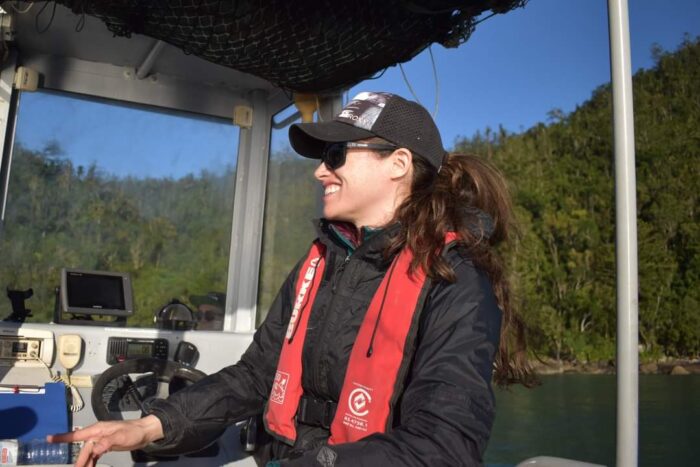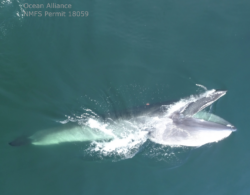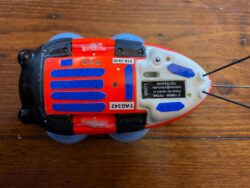
Listening In to Learn about Sei Whale Behavior

Photo credit: Dana Cusano
Written by: Dana Cusano, National Post Doctorate Fellow at the National Marine Sanctuary Foundation
I often get asked what I do for my postdoctoral research here at Stellwagen Bank National Marine Sanctuary. To keep things simple, I often say that I study sei whales. The overwhelming response, from family, friends, and even other marine scientists, is: a what?
What is a sei whale?
The sei whale is the third largest animal on the planet. They can be up to 20 meters in length and weigh up to 30 metric tons. They live in all of the world’s ocean, including the western North Atlantic, where they can sometimes be found close to shore in Stellwagen Bank National Marine Sanctuary. Yet, we know very little about this animal.
OK, so what do we know (in a nutshell)?

A sei whale lunge feeding at the surface with a suction-cup tag attached to its back. Photo credit: Ocean Alliance, NMFS Permit 18059
Sei whales are baleen whales, which means they don’t have teeth. Rather, they have large plates of flexible hairs embedded in the gums. Baleen whales are filter feeders, meaning they take in large quantities of water and prey (like fish or krill) and filter out the prey as they push water back out with their tongues. Sei whales are unique in the whale world in that they can both skim feed, like North Atlantic right whales, and lunge feed, like humpback whales.
We also know that they make a few calls, most notably one called a “downsweep”, which sounds a bit like a moan. Scientists have used passive acoustic monitoring systems, which are recorders placed out in the ocean to monitor sounds, to detect the presence of sei whales by listening for these downsweeps. From these data, we know something about where sei whales can be found around the world.
Importantly, we also know they are endangered. It is estimated that nearly 17,000 sei whales were killed before commercial whaling was banned in 1986. Approximately 6,300 sei whales remain in the population around the Northeast US and Canada.
What don’t we know?
Lots! We don’t know how many populations there are around the world (also known as stocks). We don’t know what habitats they like the most. We don’t know much about their movement, either on a large scale (migration) or small scale (days to weeks). And we know very little about their behavior, including social, diving, and vocal behavior. This is where I come in, with my long list of colleagues of course.
What have we recently learned?
I started my post-doc in 2022 with the National Marine Sanctuary Foundation. Since then, my colleagues and I (including Syracuse University, Stellwagen Bank National Marine Sanctuary, Michigan State University, and Ocean Alliance) have used state of the art technology to look at the behavior of sei whales. For the first time in the North Atlantic, we were able to put suction-cup digital recording tags on the backs of sei whales. These tags are a marvelous feat of engineering. They have multiple sensors that allow us to recreate the dives and movements of animals underwater. They also have an underwater microphone (called a hydrophone) that lets us record all the sounds an animal hears – and makes.

One of the Digital Acoustic Recording Tags (DTAGs1) used to record the movement and sounds from sei whales. Photo credit: Dana Cusano
After going through over 170 hours of data, I made a startling discovery. Sei whales make more than just simple moans. My colleagues and I found evidence of three new call types that scientists didn’t know they made. We still don’t know why they make these sounds, but we did discover that they make some sounds more often during certain parts of the day, and that there are some differences between males and females. After looking at the dive data from the tags, we also noticed that they spent almost all of their time in the top 10 meters of the water column, with some animals never going below 5 meters. This is another thing we didn’t know, and a big deal because that puts them at a very high risk for ship strikes, similar to what we see with North Atlantic right whales that also feed at the surface regularly.
We have a lot left to do, and a lot more to discover, but we have already uncovered many new things about sei whales that we didn’t know before. As with all scientific discoveries though, we still have more questions than answers, and perhaps even more questions than ever.
1 Johnson, M. P., & Tyack, P. L. (2003). A digital acoustic recording tag for measuring the response of wild marine mammals to sound. IEEE journal of oceanic engineering, 28(1), 3-12.
